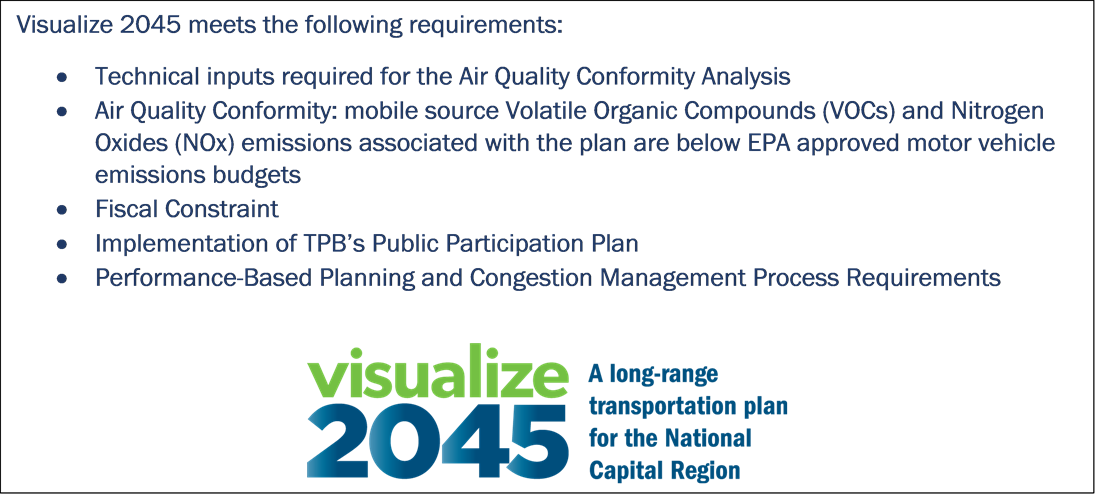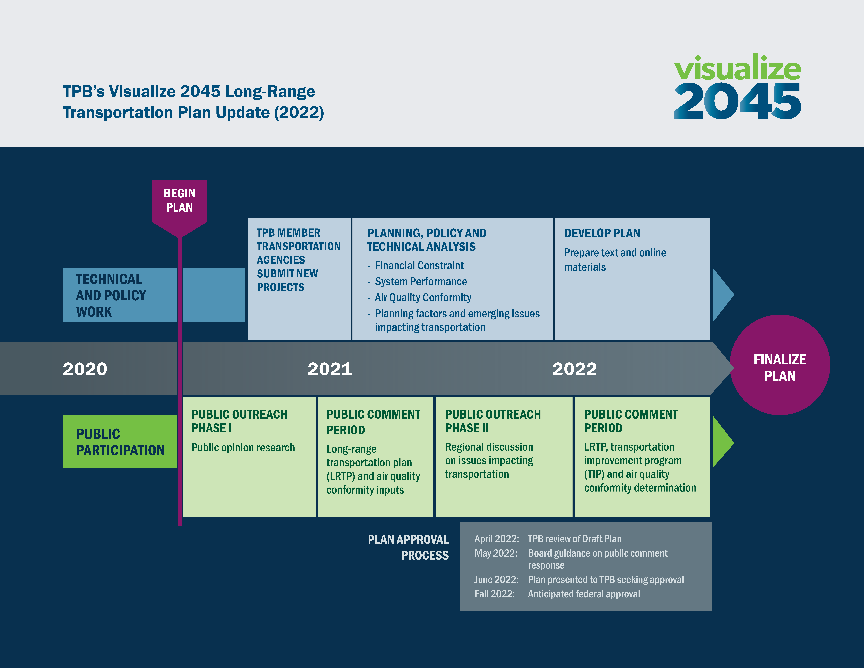On June 15, the National Capital Region Transportation Planning Board (TPB) approved the 2022 update to the Visualize 2045 Long-Range Transportation Plan, the FY 2023-2026 Transportation Improvement Program (TIP), the Air Quality Conformity Analysis Determination finding that the plan and TIP conform with the Clean Air Act Amendments of 1990, and MPO self-certification required by Joint Planning Regulations issued by the U.S. Department of Transportation, Federal Highway Administration and Federal Transit Administration.
Now is an opportune time to look at how the plan was developed and how the final plan reinforces the transportation priorities of TPB member jurisdictions. This post examines why long-range planning is conducted, the process TPB follows, the role of public engagement, Visualize 2045’s relationship with other TPB plans, and next steps.
Long-Range Planning for the Region
The Visualize 2045 Plan Update sets the foundation for why long-range transportation planning is important for the TPB.
Visualize 2045 includes both long-range and short-range strategies and actions that provide for the development of an integrated multimodal transportation system (including accessible pedestrian walkways and bicycle transportation facilities) to facilitate the safe and efficient movement of people and goods in addressing current and future transportation demand.
As a metropolitan planning organization (MPO) long-range transportation plan, Visualize 2045 must meet the requirements set for transportation plans in federal metropolitan planning regulations (23 CFR § 450.324), The U.S. Department of Transportation stipulates a minimum 20-year planning horizon for the plan. MPOs in air quality nonattainment and maintenance areas such as the National Capital Region must review and update the plan at least every four years. The purpose of these updates is to “confirm the plan’s validity and consistency with current and forecasted transportation and land use conditions and trends and to extend the forecast period to at least a 20-year planning horizon.”
As a regional plan, Visualize 2045 illustrates how the TPB, its member jurisdictions, and independent transit agencies work together to achieve shared goals and directional steps to meet those goals. While each transportation agency in the region sets policies and funds plans and programs, projects that rise to regional significance are included in the plan’s project list as long as there is sufficient revenue available to pay for the projects. In addition, the plan reports on the performance of the transportation system based on the TPB’s analysis. This analysis, combined with public input and state and local initiatives, enables the region to set priorities and develop strategies on a continuing basis to maintain, improve, and enhance the metropolitan Washington region’s transportation system.

A Two-Year Planning Process
When the TPB met in June 2022 to approve the plan update and accompanying documents, that point marked the culmination of a two-year, multi-step planning process. As shown in the timeline graphic below, Visualize 2045 progressed through the following stages in 2020 - 2022:
- The TPB identified transportation priorities and policies.
- Chapter 3 of the draft plan update outlines the TPB policy statements and documents that communicate the region’s transportation goals, priorities, and needs that member agencies are to consider when developing and selecting projects to fund and implement.
- TPB member jurisdictions submitted projects for inclusion in the TIP and Visualize 2045 plan.
- TPB staff conducted technical analysis.
- Financial constraint
- System performance
- Air quality conformity
- Planning factors and emerging issues impacting transportation
- TPB staff conducted public outreach and received comments on the inputs to the plan.
- TPB staff prepared and conducted a comment period on the draft final plan, Air Quality Conformity Determination, and TIP.

Source: TPB
Public and TPB Member Engagement
Public participation was an integral part of plan development over the two-year period, providing insight into how the region’s residents interact with the transportation network every day. In the fall of 2020, a Voices of the Region survey of residents in the region solicited information on attitudes and behaviors related to transportation topics. In summer 2021, the TPB conducted a virtual public engagement campaign, called Aspiration to Implementation to solicit input from the public about ways in which regional transportation projects, programs, and policies have affected their daily lives. The second segment of public outreach consisted of 11 virtual focus groups, designed to reach hard-to reach populations, in winter 2021. Over one hundred residents from around the region discussed their experiences, challenges, and opportunities related to transportation equity, safety, and climate change – the three Visualize 2045 plan emphasis areas. Reports and a Story Map documenting public outreach activities can be found at https://visualize2045.org/voices-of-the-region/.
Read More: Visualize 2045: Mapping Public Outreach and Regionally Significant Projects
Visualize 2045’s Connection to Other TPB Plans
What happens when transportation projects in the region are important to residents, businesses, and local jurisdictions, yet they do not meet the requirements for inclusion in the constrained element of the long-range transportation plan? This is when other plans have a role in the long-range planning process by supporting broader transportation network priorities beyond traditional highway and transit projects.
The Bicycle and Pedestrian Plan for the National Capital Region documents facility improvements (e.g., trails, bike lanes, pedestrian crossings), studies, actions, and strategies that the region proposes to carry out by 2045—-the same planning horizon as the long-range transportation plan. For example, the Bicycle and Pedestrian Plan explains how the bike plan coordinates with the aspirational element of Visualize 2045. Two of Visualize 2045’s Aspirational Initiatives focus solely on bicycle and pedestrian movement: Improve Walk and Bike Access to Transit and Complete the National Capital Trail Network.
A second plan that informs Visualize 2045 is the National Capital Region Freight Plan, which outlines the TPB’s approved freight policies. The freight plan inventories the existing network, analyzes demand, and tracks regional truck, rail, and air cargo trends. An update to the freight plan is expected to begin in 2022.
Read More: Visualize 2045 Plan Update offers interconnected solutions for the region's transportation challenges
Next Steps
Now that the 2022 Visualize 2045 Plan Update has been approved, TPB staff begin the process of updating Equity Emphasis Areas (EEAs) and conducting further analyses to support implementation of projects in the plan and TIP. These steps reflect the continual nature of long-range planning and the ongoing development of the transportation network in the region.
- Staff are updating the EEAs using the TPB-approved methodology
- EEAs in the region are census tracts with high concentrations of individuals with low income, communities of color, or both. EEAs serve as a planning tool to assist TPB member agencies as they consider equity in the planning process and to examine demographic patterns in the region.
- Staff will conduct the federally required Environmental Justice Analysis on the approved plan
- TPB staff will conduct a federally required environmental justice analysis to examine how the future transportation system is forecasted to serve the EEAs compared to the entire region. This analysis is used to inform plans and to inform planning and development of the long-term projects in the plan.
- Staff are working internally regarding the next update and expect to share more about that process with the TPB and its committees in coming months
The latest information on Visualize 2045 and copies of the final plan and TIP are available at https://visualize2045.org/.